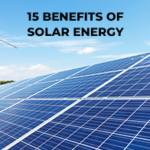Alternative to Solar Panels That Can Make a Difference in the Modern Era
Renewable energy has become more of an imperative with global power needs increasing and carbon footprint reduction more of an aim than ever. Solar is among the most commonly-utilized renewables; however, installing panels is costly, and only some have access to suitable infrastructure.
Luckily, alternative power solutions make an impactful contribution toward decreasing our dependence on traditional energy sources; in this article, “US Energy Discounts” will help you to explore solar panel alternatives which may help achieve energy efficiency without breaking the bank.
Major Solar Panel Alternatives
Wind Turbines
Wind turbines have long been considered an established form of renewable energy, harnessing wind’s force to generate electricity by turning blades that power a generator that creates current.
Wind turbines come in all sizes depending on your energy requirements; small or large options can even be installed directly onto properties with sufficient room if that suits you better for them; they may even prove more cost-effective than solar panels in specific locations due to consistent winds!
Hydroelectric Power
Hydroelectricity is produced by harnessing the energy of moving water to generate electricity, typically achieved through dam construction across rivers or other bodies of water and creating reservoirs which can then be used as sources for hydroelectric generation.
Hydroelectricity provides highly-effective renewable energy solutions and powers entire communities. But installation requires large volumes of water, which might not always be accessible or suitable in some regions.
Geothermal Energy
Geothermal energy is generated by harnessing the earth’s natural heat source and using this to generate electricity. Geothermal power plants use geothermal power’s highly efficient renewable source in many locations worldwide. However, geothermal installations may require investment or be unsuitable in all instances.
Micro Hydropower For Your Home
For those with a flowing stream running throughout their home, there’s another simple and reliable solar energy option – small hydropower. Illustration of green backgrounds shows how water flows from higher elevations through a stream and then a hydro turbine at lower elevations, causing an unstoppable flow of water, which turns the turbine to generate energy.
Micro hydropower systems produce hydroelectric power and are an ideal solar energy alternative. Microhydro production can range between 5 and 100 Kilowatts. There are turbines classified as pico hydro with smaller than five kW power. A 10-kW turbine can supply enough energy to power a vast house, a small farm, or even a modest tourist attraction.
The Run-of-the-River is the most basic form of effective micro hydropower. It is comprised of the following elements:
- Forebay or another structure designed to capture water.
- Pipeline or water conveyance channel that carries the water to turbines.
- A turbine (Reaction or Impulse) pump, turbine, or waterwheel transforms the energy from flowing water into fuel for rotation.
- The generator or alternator converts this rotation to electricity.
- Regulator to control the generator.
Biomass
Another alternative power solution today, biomass, can be used as an electricity generation source. Mainly composed of organic material derived from wood, crops, or animal waste that is burned for heat generation before power generation takes place using electricity generators like solar panels – biomass can even provide cost-cutting advantages over them!
Thermoelectric Generators
Thermoelectric generators offer an alternative way of producing electricity that stands apart from solar panels in terms of efficiency. Instead of directly converting heat into energy like solar panels do, thermoelectric generators now generate heat by turning heat into electricity. Making this technology highly cost-efficient and versatile enough for various settings and uses.
However thermoelectrics should generally only be employed on small-scale applications where additional amounts are generated quickly and sufficient for immediate consumption.
Solar Ovens
Are you a baker who is often in the kitchen? If so, you’ll realize that your electric cooker consumes lots of energy. A great option is purchasing an electric oven that cooks food with sun-generated heat. Yes, it is just as effective as the conventional oven.
The ovens come in various sizes and styles and are easy to set up and operate. All you need is sun, and you’re set to go. They’re inexpensive and effective and can reach temperatures of 350–400 degrees Fahrenheit when you’ve got the proper solar oven.
Solar ovens can also be used for camping since they’re portable and light. There are a variety of solar grills for barbecuing and cooking.
Conclusion
Solar panels may be one form of renewable energy, but other solutions are available that are just as viable a source. Consider wind turbines, hydroelectric power, geothermal energy harvesting systems. And thermoelectric generators, among many others, as potential means to produce electricity generation solutions.
Each option offers its own set of benefits and drawbacks; finding which is ideal will depend on your specific circumstances. However, by exploring alternative power solutions you could make an essential step toward decreasing reliance on traditional sources and contributing towards creating a more sustainable future!




